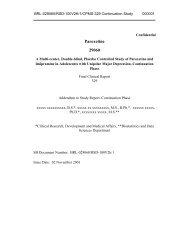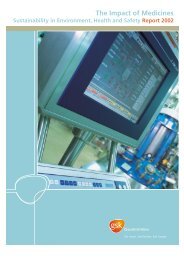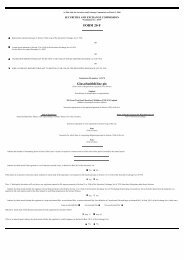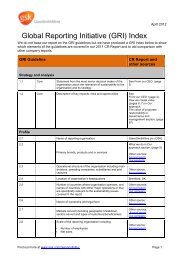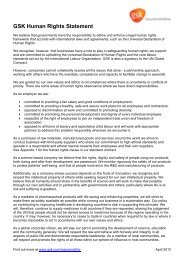GSK Annual Report 2002
GSK Annual Report 2002
GSK Annual Report 2002
You also want an ePaper? Increase the reach of your titles
YUMPU automatically turns print PDFs into web optimized ePapers that Google loves.
Research and development<br />
Safety of marketed products is a potentially significant risk and a<br />
matter of great concern to GlaxoSmithKline, as is the conduct of<br />
laboratory and clinical practices in R&D. These must be in<br />
accordance with applicable laws and regulations as well as with<br />
corporate standards that may exceed such requirements. All<br />
pharmaceutical products bring with them benefits and risks,<br />
including potential side effects. Pre-clinical and clinical trials are<br />
conducted during the development of potential products to<br />
determine the safety and efficacy of products for use by humans<br />
following approval by regulatory bodies. In spite of these efforts,<br />
when drugs are introduced into the marketplace, unanticipated<br />
side effects may become evident. The Group views the use of<br />
animals and human tissue in the testing required to develop new<br />
products as another risk.<br />
Marketing and sales<br />
The Group operates globally in complex legal and regulatory<br />
environments that often vary among jurisdictions. The Group’s<br />
policy is to conduct marketing in accordance with applicable laws<br />
and regulations as well as with corporate standards that may<br />
exceed such requirements. Any failure to observe applicable<br />
marketing codes, rules regarding government pricing, management<br />
of samples, and legal restrictions on sale and marketing practices<br />
may create significant risks to the commercial sectors and the<br />
Group. Failure to comply may result in legal proceedings.<br />
Legal and intellectual property<br />
Product liability, intellectual property, antitrust and government<br />
investigations, and related private litigation are potential risks to<br />
GlaxoSmithKline, and the Group is involved in various legal and<br />
administrative proceedings in these areas. The outcome of these<br />
proceedings cannot be predicted with any level of certainty.<br />
There is also a potential risk that third parties may allege that<br />
the marketing of the Group’s own products will infringe the<br />
intellectual property rights of those third parties.<br />
Finance<br />
There are potential risks surrounding the Group’s ability to forecast<br />
the future and thus uncertainty about its ability to meet financial<br />
targets set out in its budgeting process. The Group invests in new<br />
products and ventures based on assumptions about the success of<br />
those efforts that may prove to be inaccurate. In addition, there<br />
are potential risks around the Group’s treasury operations including<br />
tax liabilities, transfer pricing, and the possibility of trading losses<br />
and counterparty fraud. Compliance with evolving financial<br />
disclosures and other legal reporting requirements constitute risks.<br />
The Group’s pension liabilities represent a further area of potential<br />
risk. Further discussion may be found in Note 33 to the Financial<br />
statements, ‘Employee costs’.<br />
Manufacturing<br />
Maintaining supply of key GlaxoSmithKline products is a potentially<br />
significant risk. The Group’s policy is to take reasonable measures<br />
to ensure uninterrupted supply of product, including manufacturing<br />
in accordance with applicable laws and regulations as well as with<br />
corporate standards that may exceed such requirements. The<br />
Group takes efforts to minimise the single sourcing of key products.<br />
Rationalising the supply chain and balancing manufacturing<br />
capacity present other risks that could potentially disrupt the supply<br />
of important products.<br />
Corporate governance GlaxoSmithKline 37<br />
Information technology<br />
Protecting information technology assets is an increasing risk as<br />
businesses extend networks, systems and data to third parties,<br />
and as dependency on the Internet for communications increases.<br />
Ensuring proper systems validation and electronic records and<br />
signatures are key regulatory issues and matters of potential risk<br />
for the Group. Web systems accessible to the public must comply<br />
with legal and regulatory requirements and represent potential<br />
risks. Other potential risks include use of personally identifiable<br />
information, electronic record retention, outsourced business<br />
applications, and susceptibility to viruses and outside incursions.<br />
With much of the Group’s business dependent upon electronic<br />
means, disaster recovery also poses a potential risk.<br />
Security, environment and safety<br />
Threats to the security and well being of our employees, property<br />
and the environment present significant risks for which appropriate<br />
safeguards and precautions are continually reviewed and upgraded.<br />
Employee injury, changes in health due to occupational conditions<br />
and plant management and the potential impact of plants on the<br />
environment are potential risks the Group addresses through a<br />
process that sets targets and provides guidance on how results<br />
may be achieved.<br />
The Combined Code<br />
The company seeks to uphold, and to report on compliance with,<br />
best practice in corporate governance. The Board is reviewing the<br />
recommendations from Derek Higgs’ ‘Review of the role and<br />
effectiveness of non-executive directors’ and Sir Robert Smith’s<br />
<strong>Report</strong> on ‘Audit Committees, Combined Code Guidance’ and<br />
intends to ensure that the Group will continue to comply with<br />
the Listing Rule requirement in relation to ‘The Combined Code<br />
– Principles of Good Governance and Code of Best Practice’ (the<br />
Combined Code) which is issued by the UK Listing Authority. The<br />
Combined Code comprises recommendations as to best practice<br />
in terms of the control and reporting functions of the board of<br />
a company. The Combined Code sets out principles under the<br />
headings of:<br />
• directors<br />
• directors’ remuneration<br />
• relations with shareholders<br />
• accountability and audit and prescribes more detailed<br />
provisions in respect of each principle.<br />
Specifically the provisions require directors to report in the<br />
<strong>Annual</strong> <strong>Report</strong> on:<br />
• directors’ remuneration<br />
• directors’ responsibility for the Financial statements<br />
• going concern<br />
• internal control.<br />
Compliance<br />
The Directors’ report on compliance with the Combined Code<br />
and other corporate governance requirements, and their reports<br />
in accordance with the provisions of the Combined Code, are set<br />
out under ‘Directors’ statements of responsibility’ (page 74).








